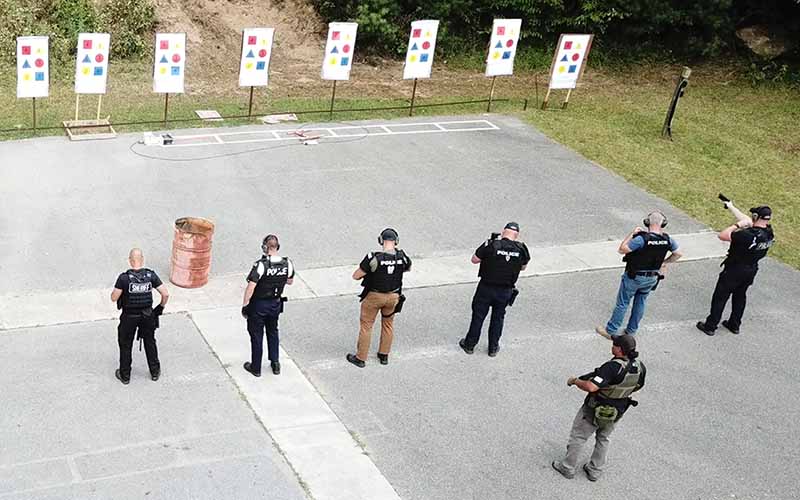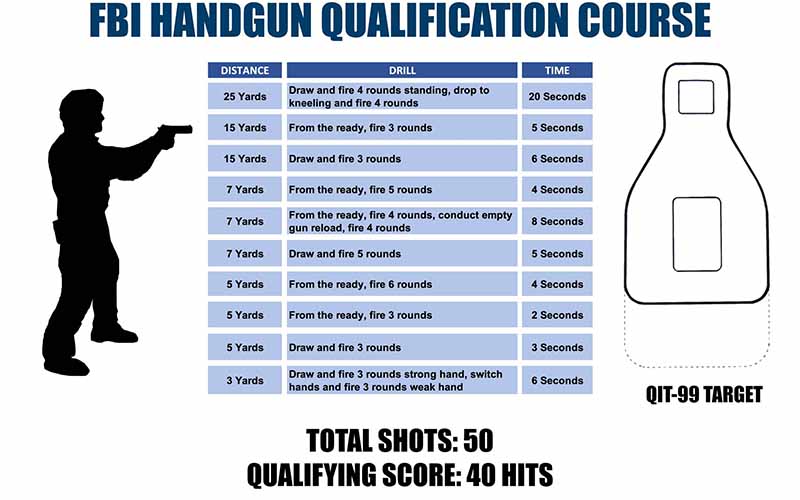
The author debunks some dangerous assumptions that surround qualification drills and what they really mean.
The military and law enforcement have long used qualification courses to validate a soldier’s or cop’s shooting skill. Qualification is also a part of most defensive handgun training courses and, in some cases, it’s a requirement to obtain a concealed carry permit. The difficulty of these shooting evaluations varies; there’s no universal standard, and a passing score is subjectively set by the responsible administrating body.
So, what specifically does the successful completion of a qualification course really mean?
I’m not exactly sure. This is partly because of the varying requirements, but it’s also because of the tendency to rank performance—based on score—with identifiers such as marksman, sharpshooter, expert or master. It’s hard to divine any real meaning from these scores or ranks, which are mostly used to incentivize shooters to strive to perform at a higher level. If you’re qualified, you’re qualified, right?
Beyond that, what else matters?
I’m not exactly sure about that, either.
On my first day of work as a police officer 32 years ago, the range officer took me to qualify with my service revolver, and I shot expert on the department’s qualification course. But, in no one’s imagination should I have been considered an expert—or maybe even qualified—with a handgun in a law enforcement setting. I didn’t receive any law enforcement specific training; all I’d managed to do was hit the required area of the target 90 percent of the time.
This is one of the two things that troubles me the most about qualification courses.

Troubling Parameters
The object of shooting is hitting, and a failure to hit what you’re shooting at is, by any measure, a failure. Had I only achieved 70 percent of my hits on that course of fire I would’ve still qualified. How could that be? How could a police officer fire 60 rounds, miss 18 times and still be considered “qualified” to carry, and, more importantly, shoot a handgun in a public setting where real, live, innocent human beings might be walking around Googling their smartphone?
When I went to work as a special agent for the railroad police, I was shocked to discover that, to qualify with my duty handgun, I had to shoot 100 percent—no misses were allowed. This made perfect sense because you’re responsible for every bullet you fire. The other surprise was what the qualification course amounted to. Though my memory is now a bit cloudy on the exact details, it went something like this:
You started walking toward the target with your pistol in the holster. At about 5 yards from the target—on the start signal from the instructor—you drew your pistol and had to place multiple shots inside an 8-inch circle in just a couple seconds. Simple, right?
In theory, maybe, but not so much in practice. As a law enforcement firearms instructor, what I ultimately learned was that the shooters who could pass this simple qualification course also had the ability to pass most any other qualification course in use by other law enforcement agencies.
Interestingly, a few years ago I asked retired Sergeant Major John “The Sheriff of Baghdad” McPhee of SOB Tactical if he could require a shooter to perform a single drill to establish proficiency, what it would be? McPhee said, “That’s one of the most common-sense questions I’ve had in a long time,” and he went on to say he’d use a drill he calls the Placement Test.
The Placement Test
In McPhee’s Placement Test, which is about as minimalist as it gets, you’re required to draw from the holster and put three shots inside a 3-inch circle, at 3 yards, in less than 3 seconds. According to McPhee, if you can do this, you can shoot—meaning, you have a solid grasp of the fundamentals. It’s also a very real-world, because as John’s research in self-defense shootings has shown, in a generic way this drill closely replicates real-life situations. Ironically, the drill is very similar to my often used Forty-Five Drill, which mandates drawing from a concealed holster and putting five shots, into a 5-inch circle, at 5 yards in less than 5 seconds.
Our tests are very similar to the qualification course the railroad police used. What’s most important is that they’re 100 percent pass or fail. Though you could classify performance based on the actual time to successfully complete the drill, it’s unnecessary. These are no-B.S. drills that plainly illustrate whether you can shoot a defensive pistol … or not.
I know some of you are screaming, “That’s not enough shooting and does nothing to document that you can hit at greater distances, shoot from behind cover or from other positions!” You’d be correct. But, if you can pass either of these drills, you’re very likely skilled enough with a handgun to do all of those things, especially with a bit of training. And let me repeat that last word with emphasis: training!

What Really Matters?
When we showed up for qualification day with the railroad police, qualifying was the first thing we did. It took about an hour for a bunch of us to do it—one at a time with an audience watching—and then we spent the rest of the day learning and practicing with our pistols to the point where we were challenged with scenarios and drills of ever-increasing difficulty. We did the single most important thing that too many police departments, military units and civilian gun owners fail to do. We trained!
And that’s the second thing that bothers me about qualification courses—especially those that turn out marksmen, experts and masters—which is also the main point of all this pontificating: You should not put too much credence on your ability to qualify on any course. Sure, you might need to shoot a passing score to go to war, work the street or carry a concealed handgun, but qualifications tend to bring with them the illusion that you’re actually qualified. And that tends to develop the notion or mindset that no other work, training or practice is necessary.
Being qualified by the government, a school, or some other organization is one thing, but it has no real bearing on the ultimate goal—which is actually being capable of winning a fight with a pistol. The only way to come even close to that is through frequent and continual efforts to learn, train and improve your skill set that challenge you to get better so that you can always hit what you shoot at and never miss. One hundred percent!
Editor's Note: This article originally appeared in the March 2024 issue of Gun Digest the Magazine.
More On Shooting Drills & Training:
- Video: Target Transition Training With The Dot Drill
- The Shot Timer And Defensive Handgun Training
- Gun Digest’s 10 Best Shooting Drills And Firearms Training Posts
- MantisX: Simple And Effective Training
- Video: Is A Full-Sized Pistol The Best Training Option?

Next Step: Get your FREE Printable Target Pack
Enhance your shooting precision with our 62 MOA Targets, perfect for rifles and handguns. Crafted in collaboration with Storm Tactical for accuracy and versatility.
Subscribe to the Gun Digest email newsletter and get your downloadable target pack sent straight to your inbox. Stay updated with the latest firearms info in the industry.

![Best Concealed Carry Guns In 2025 [Field Tested] Wilson Combat EDC X9S 1](https://gundigest.com/wp-content/uploads/Wilson-Combat-EDC-X9S-1-324x160.jpg)


![Best 9mm Carbine: Affordable PCCs [Tested] Ruger Carbine Shooting](https://gundigest.com/wp-content/uploads/Ruger-Carbine-Shooting-100x70.jpg)
![Best AR-15: Top Options Available Today [Field Tested] Harrington and Richardson PSA XM177E2 feature](https://gundigest.com/wp-content/uploads/Harrington-and-Richardson-PSA-XM177E2-feature-100x70.jpg)

I (full disclosure-aging, overweight non-police bureaucrat with a couple of recently healed fractures) once shot a night qual. Mostly pistol with a little shotgun thrown in. Low to no light except handheld, shoot and move, non-shoot targets, reloads. I qualified somewhere in the low 80s. Not good enough by the author’s standards or mine. However, immediately following, the SWAT team shot the same qual. Not one broke 70 and some were down in the 50s. Seems to make the author’s point.
The one-shot qualification developed by O. Frank
Repass for the Orlando PD ( retired) was the simplest and yet valid “qualification” I’ve ever seen.
I doubt many officers could pass it today.
Your placement test seems reasonable to me but especially to civilians that will probably have to shoot someone ONCE in their lifetime, if any at all.